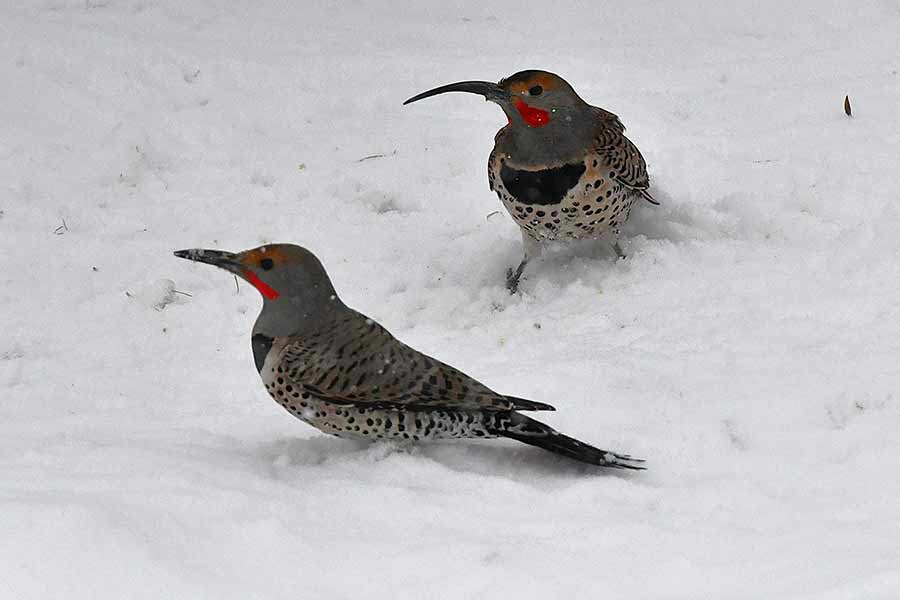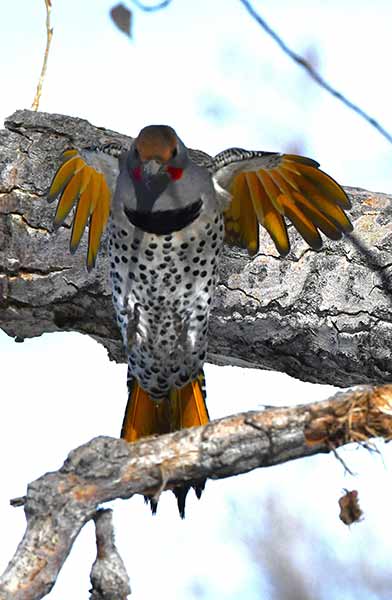An odd variety of downy and northern flicker birds have been eating in my backyard feeder
Published at | Updated at
While studying some of the birds feeding in my backyard, I saw a small woodpecker that acted and looked like a downy. The only problem was that it had an almost black belly instead of a white one. The markings on the head that should have been white were a dingy gray. It looked like it had been trying to play Santa Claus by sliding down somebody’s chimney. I watched it for another two weeks and it was still the same color, despite all the bathing it did.
I sent some pictures of it to a birding expert, Darren Clark, and he said, “A cool looking bird, but the downy seems to have some weird pigment issue.”
It is a female. During Thursday’s snowstorm, it showed up with a regular-colored male who was seriously paying a lot of attention to her. It is time for their dating to begin and I hope they stick around; I would love to see what their kids look like.

We also have about 14 northern flickers who have been trying to eat as many suet blocks as we can put out. They have gone way over their budget this winter. The red-shafted birds usually live west of the Mississippi River and are the ones we see most often. Some odd ones have spent the winter with us as well.
One red-shafted bird’s bill is twice as long as it should be and is curved. The top part of its bill is about an inch longer than the bottom part, making it very hard for it to eat from the suet blocks. But it will hammer at the suet, knocking off small pieces before flying down to eat the pieces on the ground. Sometimes, it will sit on the snow and eat the pieces other birds knock off.

Other flickers are aware of its large, sharp bill. It will jab them with it to steal some of the food. He is a bully and all the rest of them know it.
Three others have color issues and appear to be crosses between the red-shafted and the eastern northern flickers, which are “yellow-shafted.” The yellow-shafted birds have black cheeks instead of red cheeks. The yellow-shafted also have a red chevron on the back of their heads, while the red-shafted do not.
There is a third sub-species called a “gilded” flicker that lives in southern California and Mexico. It does not usually show up in the northern United States. They are described as “having a yellow-shafted body with a red-shafted head.”

I thought one of my odd colored flickers was a gilded one, but when it turned away from me while eating, I saw a faint hint of a red chevron on the back of its head. That made it a cross between a red and a yellow-shafted bird.

The other two crosses have yellow/orange under wing feathers, along with tails with a red cheek and faint chevrons on the back of their necks. Their display of mating behaviors with the regular, red-shafted northern flickers is beautiful.

We’ve had some neighbors and friends that complain about flickers pecking holes in their houses. We have never had that problem at our place, even with up to 16 of them feeding here. Flickers make holes after they hear wood-boring insects inside wood and are looking for food. Flickers also engage in “drumming” during their mating season. They will find a hollow tree or even a piece of metal and will peck at it rapidly. This is how they communicate their availability as a mate. They are not pecking holes while drumming.
If I had woodpeckers pecking holes in one of my buildings, I would be checking for insects in the wood. I love having all these flickers for the winter. They will soon be gone and replaced by other colorful birds.
For those who have been ice fishing in Ririe — it has been a good year for some of us, but the ice is getting rotten. A good way to find out the ice conditions on Ririe is to drill a hole about halfway through the ice. If you can see water filling the hole that you drilled, the bottom ice is not solid. Ice breaks down from the bottom as well as the top, creating weak spots. I chose to quit ice fishing a week earlier than a day late!

Living the Wildlife is brought to you by Yellowstone Teton Territory. Experience 7,500 square miles of untamed wilderness in Eastern Idaho's Yellowstone Teton Territory. Where majestic peaks meet endless adventure, your perfect outdoor escape is waiting. Start planning at YellowstoneTeton.com.
EastIdahoNews.com comment boards are a place for open, honest, and civil communication between readers regarding the news of the day and issues facing our communities. We encourage commenters to stay on topic, use positive and constructive language, and be empathetic to the feelings of other commenters. THINK BEFORE YOU POST. Click here for more details on our commenting rules.



